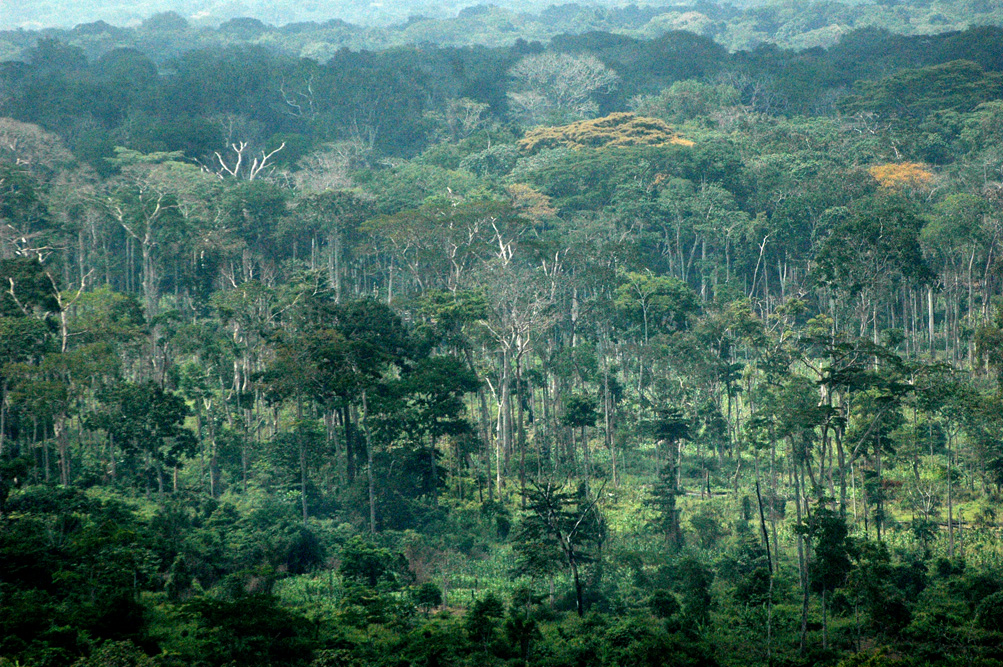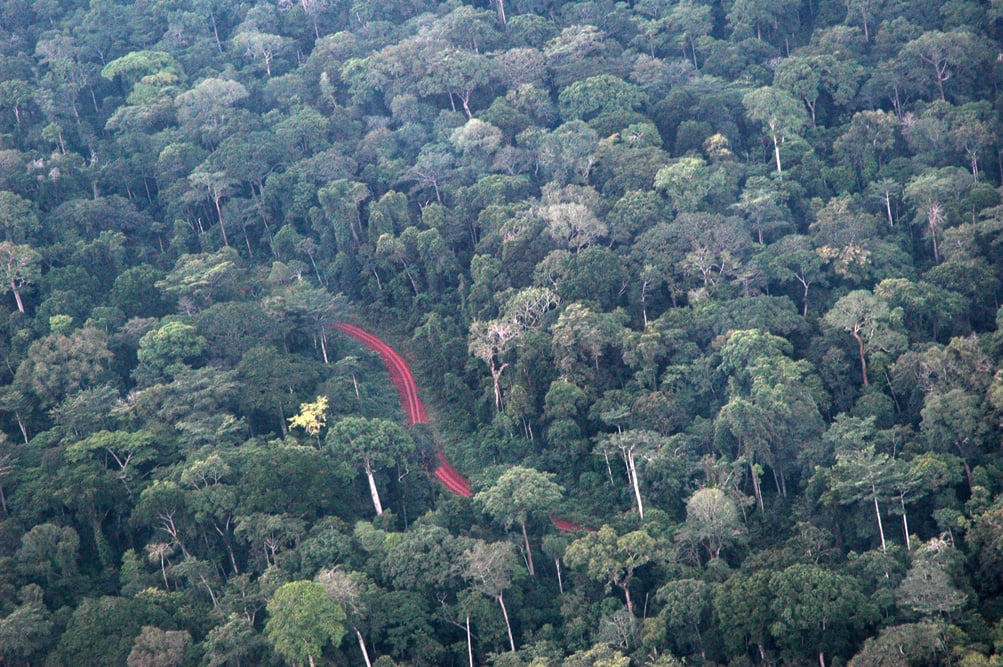Forest emerged as central to stabilizing global climate in the past decade. And that has sort of dictated international cooperation in this area in the past several years. There are many reasons why – according to the Intergovernmental Panel on Climate Change, deforestation and forest degradation are the second leading human cause of CO2 emissions contributing to global warming. It is estimated that deforestation and forest degradation account for approximately 17 percent of global greenhouse gas (GHG) emissions.

International efforts to help developing countries decrease deforestation rates must balance carbon reduction and development goals and strive to formulate clear, coherent models of change.
- International efforts to help developing countries decrease deforestation rates must balance carbon reduction and development goals and strive to formulate clear, coherent models of change. Evaluations of UN, World Bank Group and bilateral projects on deforestation and sustainable forest management often highlight the need to clearly articulate a vision of long-term progress (or theory of change) and to better define and measure the delicate balance between environmental, poverty reduction and other social goals or objectives.5 Furthermore, program managers, policy makers and evaluators must do more to capture and take into consideration ‘co-benefits’, which should be more explicitly defined in program planning and policy. Several recent evaluations have underscored the need to better understand the potential trade-offs between climate objectives and broader development benefits.6
A few evaluations have gone a step further and have questioned whether programs which may have proven successful in preventing deforestation include and provide positive benefits for the poorest households, and whether these goals are fully compatible.7 Several mention the growing agreement on the need to further encourage and promote sustainable livelihoods for those living in or near forest areas and to address land-use issues as a necessary step in reducing deforestation rates and CO2 emissions.8 Additionally, the drivers of deforestation are often factors outside of the forest sector and therefore programs designed to halt or reduce deforestation must address a broader range of related issues, including: land tenure, agricultural policies, the potential for climate smart agricultural practices, alternative livelihoods, livestock and gazing practices, urban expansion, mining policies, and other social and economic drivers of deforestation and change in land use. Encouragingly, there is evidence that program managers and policy makers have been responsive to recommendations concerning the need to better clarify program objectives and rationales. For example, the UN REDD Program made changes to its official strategy following the 2014 program evaluation. The new REDD Program strategic framework includes a clearly articulated theory of change, demonstrating that international programs have been able to adapt and incorporate learning from evaluative findings. The World Bank Group’s strategy in the forest sector has also evolved over time, in part as a result of the Independent Evaluation Group’s (IEG) findings. Fjallraven Kanken Big UK Additionally, the Forest Carbon Partnership Facility (FCPF) Readiness Fund first established an M&E framework following a recommendation made in the Facility‘s first program evaluation.

Encouragingly, there is evidence that program managers and policy makers have been responsive to recommendations concerning the need to better clarify program objectives and rationales.
Need for co-ordination, alignment and leadership from partners and donors The complexity of multilateral frameworks working to halt deforestation and the intricate international architecture of aid delivery in the forest sector has featured in a number of evaluations and reviews. While some question the necessity of the complicated aid architecture in this sector, the more general finding is that the multiplicity of institutions and financing mechanisms requires greater levels of co-ordination among donors and partners. Several evaluations underscore the need for co-operation among donors working at the country level and concerning decisions on financing for multilaterals. Overall, recent evaluations suggest that multilateral aid in the forest sector has shown mitigation effectiveness and is particularly important in helping to ensure that donors respect their environmental commitments. Pooled funding mechanisms are considered essential to gather momentum and ensure harmonization of approaches between donors. Nike Air Foamposite There is also a need for collaboration between multilateral initiatives. The 2014 evaluation of the UN REDD program, for example, recommended that UN agencies further their collaboration with the World Bank’s FCPF in order to harmonize approaches and to reduce the duplication of effort. There have been some challenges with multilateral programs and pooled funding, such as those seen with the UN REDD program, which has had a relatively slow rate of implementation. These challenges seem to stem from unanticipated obstacles and capacity gaps that need to be addressed prior to full program implementation. Recent evaluations highlight the complexity of initiatives in the sector, the slow pace of progress and the need for programs to adopt a cross-sectorial approach. Air Jordan 1 Uomo
A global program review of the FCPF conducted by IEG in 2012 summarized this view, stating that “the REDD+ readiness process is a more expensive, complex, and time-consuming process than originally envisaged” and suggested that a crosssectorial approach would help increase effectiveness. Similarly the 2014 UN REDD Program evaluation found that “UN partner agencies and participating countries should place greater emphasis on integrated crosssectorial approaches to REDD+…”. Not only is a cross-sectorial approach needed, but bilateral development providers also need to focus on environmental policy integration and the overall coherence of their international development co-operation portfolios. Asics Corrido męskie A recent evaluation by Belgium found that while many of their programs had positive results in stabilising or increasing the land area covered by forests, greater attention could be paid to negative environmental externalities, such as the impact of other programs on forest coverage. Furthermore, a 2014 SDC evaluation, ‘Swiss International Co-operation in Climate Change 2000-2012’, noted that climate change mitigation requires long-term commitment and suggested that it be “mainstreamed as an aspect of all development projects… This approach would ensure that good progress in climate change mitigation or adaptation is not undermined or ‘undone’ as a result of other interventions.” A few evaluations have expressed concern regarding the large number of partner countries now engaging in multilateral programs. In particular, there is concern that some partners interested in REDD+ readiness programs may lack capacity or have unrealistic expectations; some evaluations question the appropriateness of engaging such a large number of new partner countries when many have faced challenges moving successfully into the results based payment phase. For instance, as of early 2016 there are 64 partner countries engaged in the UN-REDD Program. Hence there are apprehensions, such as those highlighted in a 2014 ‘Real-time evaluation of Norway’s International Climate and Forest Initiative (NICFI)’, about raising the expectations of partners unrealistically when an international co-operation agreement on financing for REDD+ has so far not been put in place. The 2012 Global Review of the FCPF mentions the large number of interested client countries as a case of ‘over-demand’. Serious discussions among donors, multilaterals and partner countries need to be had to assess if the current approach of multilateral engagement with a large number of partner countries is advisable and realistic, including how these programs can best align with country generated strategies. Norway’s 2014 real-time evaluation of its forest sector program found that strong bilateral relationships, such as between Norway and Brazil, can lead to successful outcomes; however, there are concerns that this success may not be replicable with other partners. While evaluations have repeatedly highlighted Brazil as a key success story, it has often been noted that this success has been possible due largely to the strong leadership and political will in Brazil to halt deforestation. Norway played a key role in supporting Brazil and the Amazon Fund with financing and strong partnership; although the most recent real-time evaluation of Norway’s large-scale commitments in the sector suggest that Norway’s bilateral relationships with other key partners have advanced less quickly. The uneven progress has been attributed to differences in local governance and varying levels of commitment and political decision-making within partner countries. Donors such as Norway have been successful in using large financing commitments to gather support for and to influence the international dialogue on approaches in the sector. Evaluations of Norway’s and Switzerland’s development co-operation in the forest sector both conclude that their countries’ aid has been crucial in advancing the dialogue and has influenced decisions and contributed to progress made on REDD+ and in the UNFCCC climate change negotiations. Generally, there is strong recognition of the need for co-ordination among donors, particularly in regards to financing for multilaterals and on thinking about ways to improve their transaction costs and to address the challenges caused by the slow implementation process, which has often led to a lower level of disbursements than anticipated. Maglie Denver Nuggets Local ownership and inclusive engagement of national and local stakeholders

Recent evaluations suggest that more attention should be given to local ownership and ensuring inclusive dialogue with a wider range of stakeholders.

A common approach in forest sector programming has been the use of Payments for Environmental Services (PES) which have frequently been implemented under the REDD+ umbrella.
Furthermore, an IEG evaluation entitled ‘Climate Change Phase II: The Challenge of Low Carbon Development, Climate Change and the World Bank Group’ found that while PES schemes have been popular, “a substantial proportion of payments has gone to areas that are not at high risk for deforestation, diluting carbon and environmental benefits and prompting attention to targeting.” While attention to targeting and poverty has increased in PES schemes, to date there does not appear to be a strong evidence base demonstrating that conservation and poverty-reduction goals can effectively be complementary in PES programmes.
Click here to read the original article.
